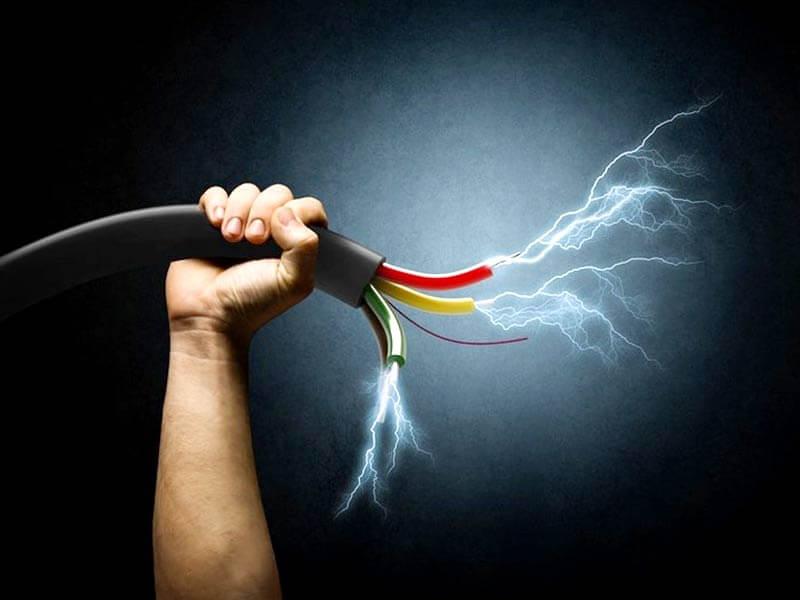When a person comes into contact with electrical energy, an electric shock occurs. The shock is caused by electrical energy flows through a person’s body. There are times electrical shock causes no injury and others where drastic damage and even death occurs. Burns are a common injury from electric shock.

Electric Shock Symptoms
There will likely be little evidence externally of injury, unless there were serious burns. There are some people who may go into cardiac arrest from lightning strike or from electric shock.
You will generally see the most severe trauma at the points of contact such as head, hands or the heels.
Other injuries in addition to burns you may see can occur from a powerful muscular contraction when they are thrown from the source. A spinal injury or internal injuries are a possibility so be on the lookout for shortness of breath, abdominal pain, or chest pain.
When checking electric shock symptoms, if you have pain in the foot or hand, or a body part that looks deformed, there may be a broken bone, caused from the violent muscle contraction from the electric shock.
Children most commonly see burns around their mouth from biting on an electric cord. The area may be charred, dark or red in appearance.
Individuals that are affected should be examined for exit and entry marks to discern the extent of injury. Areas of intense burn can indicate where the electricity traveled.
There are some individuals who suffer a heart attack after electric shock. Be sure to check for breathing and a pulse. Shock can feel like a slight sensation or cause serious injuries such as heart attack and death. You can also suffer second degree burns, hearing loss, weakness, confusion and other electric shock symptoms.
When to Call 911 for Electric Shock
If you get hit by lighting or high-voltage such as 500 volts or more, you should seek immediate medical care. With low-voltage shocks, you should call your doctor or visit an emergency room if the following applies:
- There has been five years since the patient’s last tetanus shot.
- There are burns that aren’t healing.
- Burns are getting more sore, redder or draining more.
- The patient is 20 weeks or more pregnant.
- There is a noticeable burn on the skin.
- The person has been knocked unconscious.
- There are hearing, vision, or speech troubles or there is a tingling sensation, numbness or paralysis.
- Other troublesome electric shock symptoms crop up.
What Tests Are Used for Electric Shock Diagnosis?
If you go to the ER your doctor must check for significant injuries that can’t be seen. These will include checking the brain, heart and other muscles to discern if electricity has damaged them. Your doctor will also check to make sure you don’t have any broken bones or organs if you were thrown from the source. Depending on your medical history, the following tests may be ordered:
- EKG, ECG Electrocardiogram to check your heart
- Blood count
- Checking for enzymes with urine tests (signs of serious muscle injury)
- X-rays looking for dislocations and fractures, either can come from near electrocutio
- CT scans
First Aid and Medical Treatment for Electric Shock
Electric Shock First Aid
With the right action, an injury or even death may be prevented. Electric shock first aid includes:
- Make sure to break the electric current. Use something such as rubber, cardboard or a piece of wood because it won’t conduct electricity. Be careful not to get a shock yourself. Try turning the power off or turning the breaker off. If someone is on high voltage wire, call 911 and DO NOT attempt to remove them.
- Call 911 or an ambulance.
- Keep the person still or down and do not move them. Spinal and neck injuries may go unnoticed.
- Check their responsiveness. Tap or speak to them. If they don’t respond, you may need to give CPR.
- If the person is faint or pale, make sure they lie down with the legs elevated. Try covering them with a coat or blanket until help comes.
When there are burns:
Take the burned clothing off if it’s not stuck to skin. Don’t remove anything stuck to the burn. Remove tight fighting items like clothing and jewelry immediately. Swelling may set in and cause further trouble. Don’t apply anything to the burn, including butter, medicine, ointment or ice.
Do use a moist, cold cloth or cold water to apply briefly to reduce body temperature. If the burned area is large, be careful not to overly cool the body. Try not to touch the burn. Cover with sterile dressing or clean cloth like a sheet or pillow case. Don’t use a towel or anything with heavy, loose fibers that may get caught in the burn.
How Is It Treated?
Depending on how severe the injury is or where on the body the burn happened will dictate the type of treatment your doctors decide on. Treatment will vary depending on how severe the injuries are. Some treatments include:
- Antibiotic creams and dressings for minor burns
- Severe burns will need to be cleaned and may need skin grafting.
- With severe burns on the legs, arms or hands may need surgery and possibly amputation.
Treatments for Other injuries
- Ophthalmologists may be required for eye injuries.
- Broken bones may need surgery, casting or splinting.
- Internal injuries will need specific care.
How Can I Help Prevent Electric Shock?
- Prevention can include the following measures:
- Use GFCI or ground fault circuit interrupters with electrical outlets.
- Use plastic plugs to childproof all outlets.
- Be careful with trimming trees near power lines.
- Talk to your children about electric wires and safety. Warn them against climbing and what to do if they see a fallen wire.
- Don’t touch fallen wires. Report downed lines right away. If a wire falls on you while in the car, try to drive away without touching metal in the car, until source of electricity is removed. If you can’t, call for help and wait.
Lightning Strike Protection
Be mindful of developing storms. Seek shelter when there is thunder and lightning. You can use a vehicle with a hard top, home or other building for shelter but remember dugouts, sheds, picnic shelters and lean-tos are generally unsafe. Inside, steer clear from sinks, showers, hot tubs, bathtubs, and electronics such as computers, radios, TVs and corded phones. Stay in shelter until a half an hour after the storm passed.
If caught outside without available shelter, consider lessening your chance of getting s truck by lighting by staying away from isolated trees or other tall, isolated objects. Lightning tends to strike the tallest thing, which could be you in a large clearing. Find a low spot and sit with your feet together. If you’re in a group, try to keep at least 15 feet apart from each other to avoid it travelling among you. Don’t lie down. When boating or swimming and a storm approaches, get off the water as fast as possible. If you are unable to get off the water, stay low in the boat and don’t touch the water. If there is a cabin, seek shelter there.
